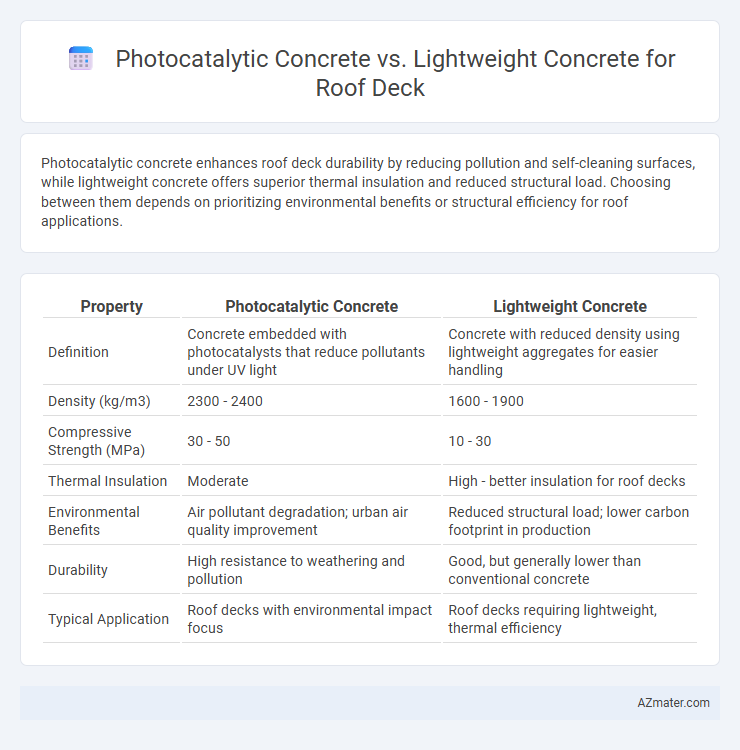Photocatalytic concrete enhances roof deck durability by reducing pollution and self-cleaning surfaces, while lightweight concrete offers superior thermal insulation and reduced structural load. Choosing between them depends on prioritizing environmental benefits or structural efficiency for roof applications.
Table of Comparison
| Property | Photocatalytic Concrete | Lightweight Concrete |
|---|---|---|
| Definition | Concrete embedded with photocatalysts that reduce pollutants under UV light | Concrete with reduced density using lightweight aggregates for easier handling |
| Density (kg/m3) | 2300 - 2400 | 1600 - 1900 |
| Compressive Strength (MPa) | 30 - 50 | 10 - 30 |
| Thermal Insulation | Moderate | High - better insulation for roof decks |
| Environmental Benefits | Air pollutant degradation; urban air quality improvement | Reduced structural load; lower carbon footprint in production |
| Durability | High resistance to weathering and pollution | Good, but generally lower than conventional concrete |
| Typical Application | Roof decks with environmental impact focus | Roof decks requiring lightweight, thermal efficiency |
Introduction to Photocatalytic and Lightweight Concrete
Photocatalytic concrete incorporates titanium dioxide, enabling the surface to break down pollutants and reduce airborne contaminants, enhancing air quality and durability on roof decks. Lightweight concrete is designed with low-density aggregates such as expanded shale or clay, providing excellent thermal insulation and structural load reduction suitable for roofing applications. Both materials offer unique benefits for roof decks, with photocatalytic concrete focusing on environmental purification and lightweight concrete prioritizing weight efficiency and energy savings.
Composition and Material Properties
Photocatalytic concrete incorporates titanium dioxide (TiO2) nanoparticles, enhancing its self-cleaning and air-purifying properties through photocatalysis, while maintaining high durability and compressive strength suitable for roof decks. Lightweight concrete typically uses lightweight aggregates such as expanded clay, shale, or pumice, resulting in reduced density and improved thermal insulation but often lower mechanical strength compared to conventional concrete. The choice between photocatalytic and lightweight concrete for roof decks depends on balancing benefits like environmental performance and weight reduction against structural load-bearing requirements.
Structural Performance and Load-Bearing Capacity
Photocatalytic concrete exhibits enhanced structural performance with improved durability and self-cleaning properties, making it resistant to environmental degradation on roof decks. Lightweight concrete offers reduced dead load, which improves load-bearing capacity by decreasing the overall structural demand, but may have lower compressive strength compared to traditional concrete. Selecting between photocatalytic and lightweight concrete depends on balancing the need for durability and environmental benefits with structural load requirements on roof decks.
Environmental Impact and Sustainability
Photocatalytic concrete incorporates titanium dioxide, enabling it to reduce air pollution by breaking down harmful nitrogen oxides, which significantly enhances urban environmental quality. Lightweight concrete reduces structural load and material usage, decreasing carbon emissions associated with transportation and construction. Combining photocatalytic properties with lightweight composition can optimize sustainability by lowering both environmental pollutants and embodied energy in roof deck applications.
Thermal Insulation and Energy Efficiency
Photocatalytic concrete improves energy efficiency on roof decks by actively breaking down pollutants and reducing surface temperatures through its photocatalytic properties, contributing to lower cooling loads. Lightweight concrete offers superior thermal insulation due to its low density and high porosity, significantly reducing heat transfer and maintaining stable indoor temperatures. Combining lightweight concrete's insulation with photocatalytic concrete's surface cooling effects can optimize thermal performance and energy savings in roofing applications.
Durability and Weather Resistance
Photocatalytic concrete offers superior durability and weather resistance for roof decks due to its self-cleaning properties and ability to break down pollutants, which helps maintain surface integrity and reduces maintenance needs. Lightweight concrete provides good weather resistance with enhanced thermal insulation and reduced structural load, but may be less resistant to abrasion and chemical degradation over time compared to photocatalytic concrete. For long-term roof deck performance, photocatalytic concrete delivers enhanced durability against environmental stressors while lightweight concrete is advantageous for improving energy efficiency and structural demands.
Installation and Construction Methods
Photocatalytic concrete installation on roof decks involves the application of titanium dioxide-infused concrete that requires standard pouring and curing processes similar to traditional concrete, ensuring pollutant-degrading surface properties without altering conventional construction methods. Lightweight concrete, produced by incorporating lightweight aggregates or air-entraining agents, demands careful mix proportioning and may require specialized handling equipment due to its lower density and different slump characteristics, impacting placement and finishing techniques. Both materials necessitate precise scheduling for curing times to maintain structural integrity, but photocatalytic concrete allows integration with typical roof deck reinforcements, whereas lightweight concrete can reduce dead loads, influencing structural design and installation practices.
Maintenance Requirements and Lifecycle Costs
Photocatalytic concrete for roof decks offers self-cleaning properties by breaking down pollutants and organic materials, significantly reducing maintenance frequency and costs over its lifespan. Lightweight concrete, while easier to handle and install due to its reduced weight, typically requires regular cleaning and maintenance to prevent surface degradation and mold growth. Over the lifecycle, photocatalytic concrete presents lower total ownership costs because of its durability and upkeep efficiency, whereas lightweight concrete may incur higher maintenance expenses despite its installation advantages.
Aesthetic and Functional Applications for Roof Decks
Photocatalytic concrete enhances roof deck aesthetics by maintaining a cleaner surface through its self-cleaning properties and pollution reduction, contributing to a visually appealing environment. Lightweight concrete offers functional advantages by reducing the overall load on the structure, improving thermal insulation, and facilitating easier installation without compromising strength. Combining photocatalytic properties with lightweight characteristics optimizes both the aesthetic appeal and functional performance of roof decks in modern construction.
Comparative Analysis and Recommendation
Photocatalytic concrete offers superior air purification properties by breaking down pollutants on roof decks, enhancing urban air quality while also providing self-cleaning surfaces that reduce maintenance costs. Lightweight concrete excels in thermal insulation and structural load reduction, making it ideal for roof decks where weight constraints and energy efficiency are critical factors. For roofing applications requiring environmental benefits and low maintenance, photocatalytic concrete is recommended, whereas lightweight concrete is preferable when thermal performance and weight savings are prioritized.

Infographic: Photocatalytic concrete vs Lightweight concrete for Roof deck
 azmater.com
azmater.com